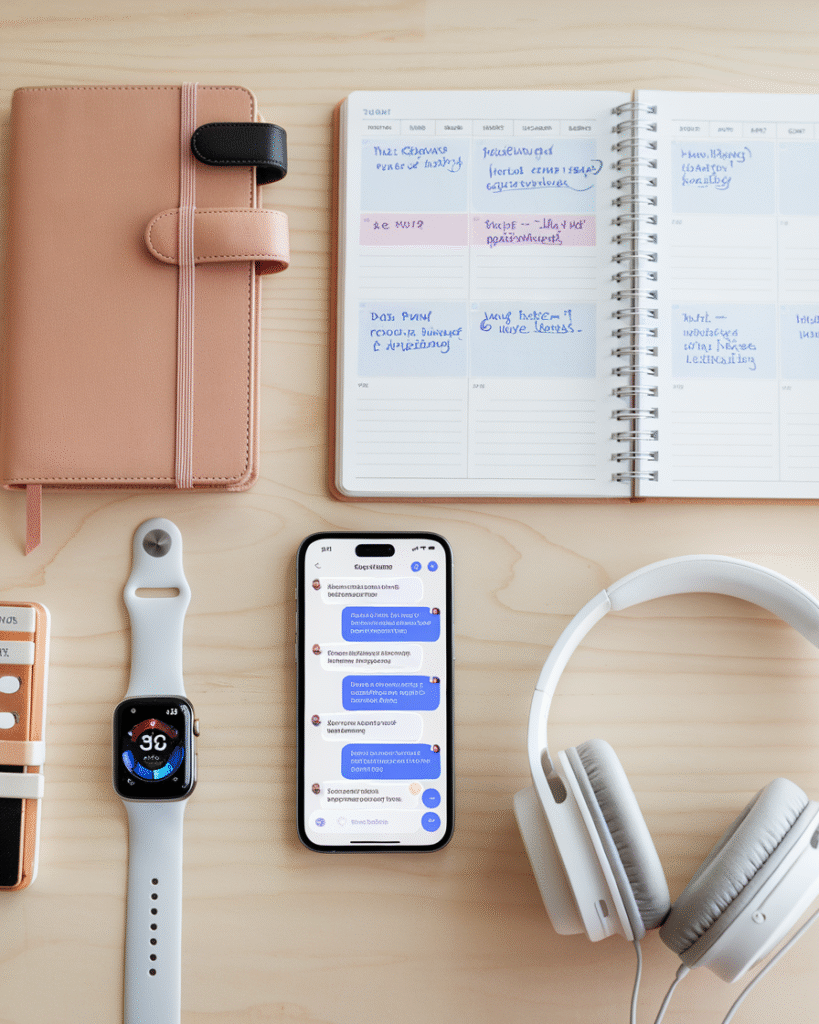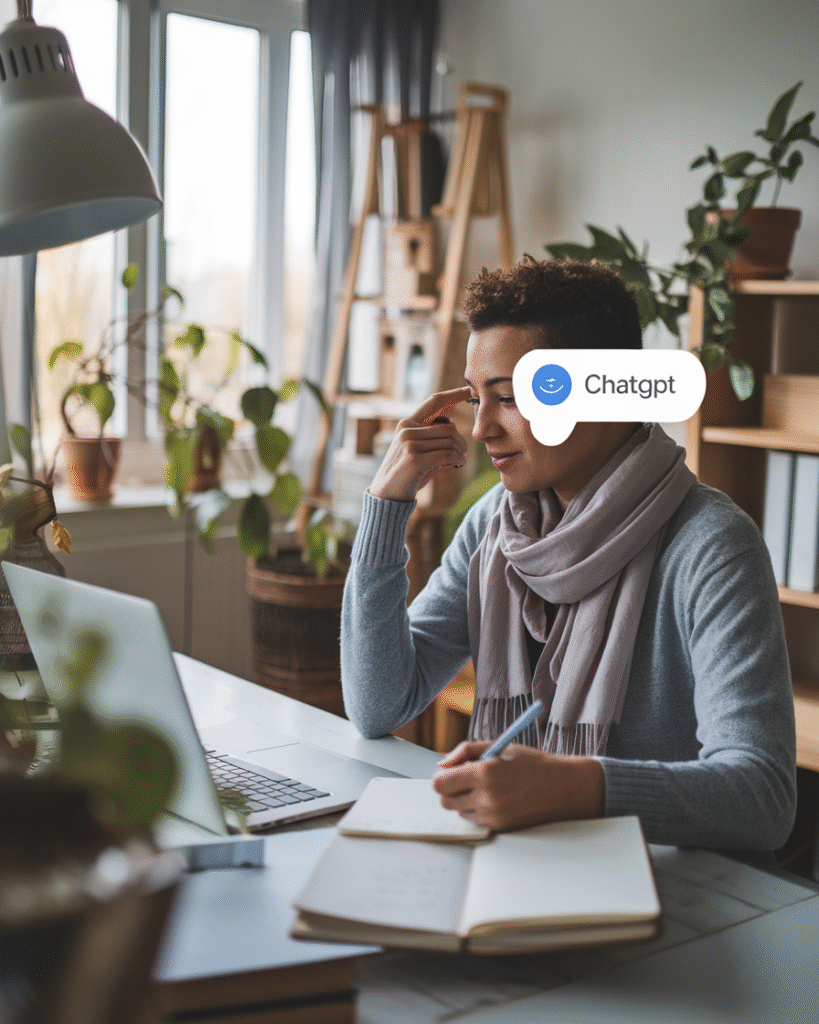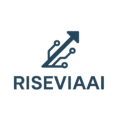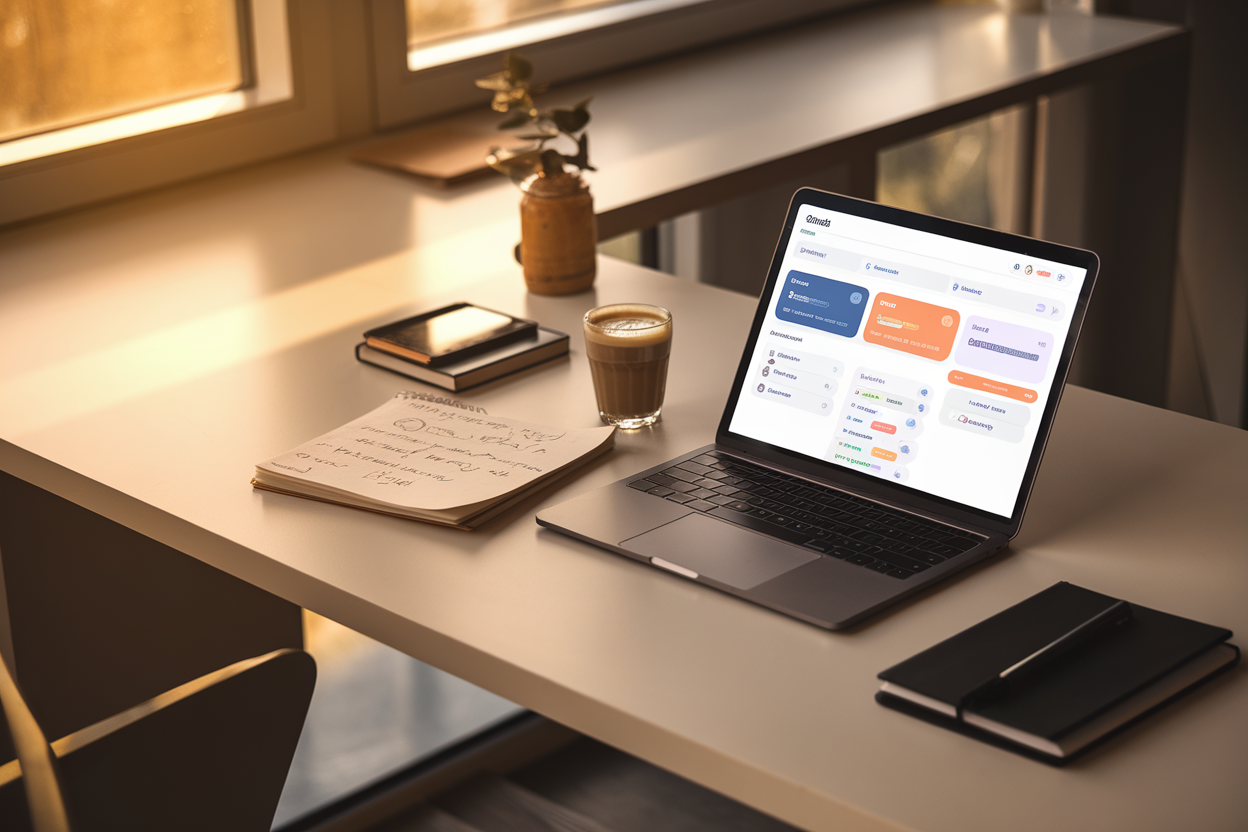ChatGPT for personal productivity hacks has become one of the most powerful ways to regain control over your time, focus, and mental energy. In a world filled with distractions, it offers something rare a way to simplify life while getting more done. Whether you’re a student trying to stay on top of classes, a freelancer juggling projects, or a professional chasing balance, this tool can become your quiet partner that helps you think clearly and act intentionally.
At Rise Via AI, we believe technology should make humans better, not busier. That’s why this blog exists. It started from a simple frustration I had during the pandemic. I was working long hours, yet I never felt caught up. I kept reading about productivity systems, downloading apps, and trying planners, but I still felt scattered. One night, I asked ChatGPT to organize my messy task list, and the results surprised me. It didn’t just sort my priorities it helped me see why I was struggling. That single moment inspired me to create this space, a blog dedicated to showing people how AI can improve everyday life in ways that feel realistic and personal.
Our mission is to help readers use tools like ChatGPT for more than just writing prompts. We want you to use them to reclaim your time, your peace, and your focus. The goal is not to turn you into a productivity machine, but to build a sustainable system that fits your mind, your energy, and your goals.
In this article, you’ll learn what makes ChatGPT for personal productivity hacks different from the endless list of “life hack” posts you’ve seen before. You’ll discover where productivity thinking came from, how it evolved into something deeper, and why AI changes the way we manage our lives. You’ll also get a clear framework you can follow step by step, along with tools, examples, and expert insights you can use right away.
If you want to explore more AI-based systems later, check out our internal guides on AI Tools to Automate Repetitive Tasks for Remarkable Wins and AI Tools for Focus: Boost Productivity and Clear Your Mind. These posts connect naturally with what you’re about to learn here. And for deeper understanding of work psychology and cognitive performance, studies from Harvard Business Review and the automation insights shared by Zapier back up how AI can shift the way people think and work.
By the time you finish reading, you’ll not only understand the mechanics behind ChatGPT productivity systems, but you’ll also feel confident creating your own daily rhythm that feels less stressful and more intentional.
Table of Contents
Table of Contents
Context & Evolution
Before diving into the practical side of ChatGPT for personal productivity hacks, it’s important to understand where the idea of “productivity” came from and why it needed to evolve.
For most of history, productivity was a term used in factories and farms. It measured how much output people could produce within a fixed time. The higher the output, the more “productive” someone was considered. But as society moved into the digital age, this definition started breaking down. People no longer produced physical goods they produced ideas, designs, reports, and creative work. The problem was, our brains didn’t come with the same structure as machines.
When personal computers arrived in the 1980s, the world entered a new era of digital work. Email was invented, spreadsheets replaced ledgers, and meetings multiplied faster than anyone could track. People thought technology would make life easier, but it often made it more chaotic. Then came smartphones and social media, which turned every idle moment into a micro-task. By the 2010s, the average person was checking their phone more than 90 times a day, splitting attention into fragments that were nearly impossible to stitch back together.
That’s when the productivity industry exploded. Books like Getting Things Done and Atomic Habits became bestsellers because people were desperate for control. Apps like Todoist, Notion, and Evernote promised order in the middle of digital noise. And for a while, they worked—until everyone realized something was missing. The real problem wasn’t lack of organization; it was lack of focus and intention. Humans were trying to manage themselves like software, and it wasn’t sustainable.
Then AI entered the story. At first, it was mostly a buzzword, but when OpenAI released ChatGPT, something shifted. For the first time, individuals could talk to technology as if it were a thinking partner. They could brainstorm, plan, and reflect through conversation, not just data entry. That’s where ChatGPT for personal productivity hacks found its magic. It became less about automation and more about collaboration a partnership between human creativity and machine logic.
Unlike past tools, ChatGPT doesn’t just store your thoughts; it helps you understand them. You can ask it to prioritize your day based on your goals, rewrite your schedule to reduce decision fatigue, or even help you create morning affirmations that align with your mindset. In this way, AI productivity tools mark a new chapter. It’s no longer about doing more, it’s about doing what truly matters.
Deep Explanation of the Core Concept (Part 1)
Now that we understand where this idea came from, let’s explore what ChatGPT for personal productivity hacks actually means in practice.
At its heart, productivity with ChatGPT is about externalizing your thinking. The human brain was never designed to juggle twenty open tasks, five mental reminders, and three overlapping goals. When you talk to ChatGPT, you’re unloading that mental clutter into a space that can organize it for you. This process helps you see your tasks from a distance, which gives you clarity that’s hard to achieve inside your head.
Let’s say you start your morning by telling ChatGPT, “Here’s everything I need to do today.” You might list meetings, chores, errands, and personal goals. ChatGPT can then help you organize them by urgency and energy level. It can even help you spot hidden patterns, like noticing you schedule creative work right after draining meetings. Once you see that, you can start rearranging your day to match your natural energy. That’s what separates AI productivity from ordinary planning it listens, analyzes, and adapts.
Another layer is reflection. Most people fail at consistency because they don’t stop to review. ChatGPT can act like a personal coach that asks, “What worked well yesterday? What felt heavy? What would you like to do differently today?” These small prompts create a loop of awareness and correction, which is the real secret behind lasting productivity.
In short, ChatGPT for personal productivity hacks is not about shortcuts; it’s about smarter systems that match how your brain works. It’s a blend of automation, reflection, and habit-building that keeps you focused on meaningful progress, not just motion.
Deep Explanation of the Core Concept (Part 2)
To really understand how ChatGPT for personal productivity hacks works, you have to see how it fits into the psychology of focus and behavior. Most people try to fix their productivity problems by adding more tools, but tools only help when the thinking behind them changes. ChatGPT gives you something deeper than a checklist, it gives you a mirror for your habits.
Think about the way we usually approach a new week. We make lists, set goals, and promise to be disciplined. By Wednesday, the energy fades because the brain is tired of making decisions. This is called decision fatigue, and it’s one of the biggest productivity killers. ChatGPT helps break that cycle by doing the cognitive heavy lifting for you. It can plan your week, sort your tasks, and even create priority systems that reduce your mental load. You no longer waste time deciding what to do next because the plan is already built for you.
Another big shift that happens when using ChatGPT for personal productivity hacks is how it transforms the idea of accountability. Traditional productivity relies on willpower, but AI introduces a layer of gentle structure. You can literally tell ChatGPT to check in with you every day, track your progress, and ask reflective questions. It doesn’t judge you, and that makes it easier to be honest about where you are slipping. Many users find this less stressful than traditional coaching or journaling.
The third key aspect is creativity. When you clear mental clutter, creativity naturally increases. ChatGPT can help you brainstorm ideas, rewrite notes, or even draft outlines for projects you’ve been avoiding. What’s powerful is that it can keep track of your tone and style, so over time, it begins to sound like you. This means your productivity system becomes a reflection of your personality, not a copy of someone else’s.
Below is a simple table that compares the traditional productivity mindset with what happens when you use ChatGPT as part of your system.
| Traditional Productivity | ChatGPT for Personal Productivity Hacks |
|---|---|
| Relies heavily on willpower and discipline | Uses conversation and feedback to support consistency |
| Works with rigid time blocks and task lists | Adapts plans to your current mood and energy |
| Focuses on getting more done | Focuses on getting the right things done |
| Encourages self-criticism when you fail | Promotes reflection and learning without guilt |
| Requires multiple apps and systems | Simplifies everything into one thinking assistant |
This shift from control to cooperation is what makes ChatGPT for personal productivity hacks so revolutionary. It gives structure without pressure and teaches you how to think clearly about your time and choices.
Real-World Applications and Impact

Now let’s move into real life, where theory meets the morning alarm clock and the messy desk. The beauty of ChatGPT for personal productivity hacks is that it works across every kind of life, not just for tech professionals or entrepreneurs.
Take students, for example. A college student can use ChatGPT to plan study sessions, summarize readings, and create flashcards for exams. Instead of flipping through notebooks, they can simply ask ChatGPT, “Summarize the key points from my notes on cognitive psychology,” and get an instant review sheet. The time they save gives them space to rest or study smarter, not harder.
In a corporate setting, managers use ChatGPT to draft meeting agendas, follow-up emails, and performance summaries. It can help identify bottlenecks by analyzing task lists and deadlines. Imagine ending a Friday by asking, “What are the top three things my team should focus on next week?” and receiving a clear, prioritized summary. That single habit saves hours of decision-making time and prevents burnout.
Freelancers and entrepreneurs have an even bigger advantage. They can use ChatGPT for personal productivity hacks to build client templates, automate outreach messages, or even brainstorm marketing ideas. A freelance writer, for instance, can train ChatGPT to remember her tone and help her plan her content calendar for the month. It’s like having a creative assistant without paying a salary.
Even outside of work, there are benefits. Parents use ChatGPT to manage family routines, grocery lists, and meal planning. You can ask it to generate weekly menus based on your pantry items, or create reminders for birthdays and appointments. It’s not about being perfect, it’s about having a little help staying balanced.
For those on personal development journeys, ChatGPT can act as a mindfulness partner. You can talk through emotions, goals, and fears in a safe and private space. Many people use it as a self-reflection journal that listens, organizes, and gently guides without judgment. That emotional balance is a form of productivity too, because clarity of mind directly impacts quality of work.
The impact is clear across all these examples. People who use ChatGPT effectively report higher focus, better organization, and lower mental stress. The more consistently they use it, the more personalized and insightful their AI partner becomes. Productivity turns from a struggle into a rhythm.
Step-by-Step Framework
To help you get started, here’s a complete step-by-step system for how to actually use ChatGPT for personal productivity hacks in your daily life.
Step 1: Define your goals clearly.
Start your journey by asking yourself what productivity means to you. It’s not just about doing more. It might mean having more free time, getting better sleep, or finishing projects without feeling exhausted. Once you know your real goal, tell ChatGPT about it. The clearer you are, the smarter its answers will be.
Step 2: Create a morning planning ritual.
Open ChatGPT every morning and share your plans for the day. Write them down as a short list, then ask ChatGPT to organize them by priority or time. This removes decision fatigue. You’ll see your day mapped out clearly before you even finish your first cup of coffee.
Step 3: Break big tasks into smaller actions.
If you feel overwhelmed, ask ChatGPT to divide a large project into micro-tasks. For example, instead of “write presentation,” it will give you “research data,” “write outline,” and “create slides.” This trick helps your brain feel progress faster, which builds momentum.
Step 4: Add reflection at night.
Before bed, open ChatGPT again and talk about how your day went. What worked? What didn’t? Ask it to summarize lessons learned and suggest what you should adjust tomorrow. This short conversation turns reflection into a habit without needing a separate journal.
Step 5: Automate repetitive routines.
Once ChatGPT knows your patterns, you can reuse prompts. For example, type “create my daily focus plan” or “generate my weekly summary.” Within seconds, it brings structure to your day. You can save these prompts for future use.
Step 6: Use it for motivation.
Some days, you simply won’t feel like working. Ask ChatGPT to give you a short pep talk, quote, or reminder of your purpose. It may sound simple, but these small boosts create emotional continuity that helps you stay consistent.
Step 7: Review weekly.
End every week by asking ChatGPT to create a short report of your wins, struggles, and next steps. This weekly reflection closes your loop and prevents burnout.
Step 8: Evolve your system.
As you grow, let ChatGPT grow with you. The prompts that helped you six months ago might not fit anymore. Keep refining how you use it until the system feels natural.
This framework shows how flexible ChatGPT for personal productivity hacks can be. You don’t have to follow every step perfectly. Start small, experiment, and let the process evolve until it feels effortless.
Tools, Platforms, and Ecosystem
When it comes to using ChatGPT for personal productivity hacks, one of the biggest advantages is how flexible the entire ecosystem has become. You don’t need to be a tech expert or a coder to make it work. You just need curiosity and a bit of structure. The tools that surround ChatGPT are designed to support almost any kind of workflow, from managing projects to improving mental focus.
Let’s start with the basics. ChatGPT itself is the core tool, but what makes it powerful is how it connects with other apps. You can use it directly on your browser, or integrate it into your daily tools like Notion, Google Docs, and Trello. For example, if you run your tasks inside Notion, you can paste a ChatGPT-generated daily plan straight into your workspace and have it ready to follow. The experience feels like having a digital assistant that works quietly in the background.
For people who love automation, platforms like Zapier and Make can take ChatGPT’s power further. You can create automations where ChatGPT generates daily summaries of your emails, sends you reminders, or even drafts replies based on your writing tone. This kind of integration means you spend less time switching between apps and more time actually doing meaningful work.
Then there are companion tools that pair beautifully with ChatGPT for personal productivity hacks. Tools like Grammarly can help refine your written communication, while time trackers such as Clockify or Toggl can give you insight into where your energy actually goes each day. When you combine those insights with ChatGPT’s ability to plan, you begin to create a full system that works with your habits, not against them.
Another overlooked part of the ecosystem is your phone. Many people forget that you can use ChatGPT on mobile, which turns it into a pocket-sized thinking partner. Whether you’re stuck in traffic, walking, or taking a break, you can use voice-to-text to talk through your next steps. This small shift keeps your mind moving forward even in downtime.
Finally, there’s the community around it. There are thousands of creators sharing prompt ideas, workflows, and examples online. If you ever feel stuck, you can find inspiration from others who are using the same tools. The ecosystem is growing every day, and each update makes it easier to personalize the experience to your needs.
When used intentionally, these platforms create a supportive environment where ChatGPT for personal productivity hacks feels less like a single app and more like an entire lifestyle shift.
Data, Research, and Expert Insights

Behind every great productivity system lies solid data and a bit of psychology. The science behind ChatGPT for personal productivity hacks is not about technology alone, it’s about understanding how the human brain works and why certain systems succeed where others fail.
Let’s start with a simple truth. The average person spends nearly half their day in a state of distraction. Research from Stanford University found that multitasking can reduce productivity by up to forty percent because the brain needs time to switch between tasks. ChatGPT helps reduce that mental switching by organizing thoughts before they scatter. When you use it to plan your day or outline a project, you’re essentially offloading cognitive strain, which frees your brain for creative and strategic work.
Another study published in Harvard Business Review noted that workers who start their day with written plans are thirty percent more effective than those who begin without structure. This is exactly what ChatGPT encourages through morning prompts. Instead of reacting to your inbox, you start your day with intention, which improves focus and lowers stress.
Experts in behavioral psychology often emphasize feedback loops as the foundation of improvement. When you use ChatGPT as a daily reflection partner, it helps you create this loop naturally. The system remembers your patterns, mirrors them back to you, and encourages consistent self-evaluation. That’s the same kind of system professional coaches use, except here it’s available to you anytime.
In the field of mental health, there’s also a growing body of research suggesting that journaling and reflection reduce anxiety and enhance problem-solving. ChatGPT acts like a journaling assistant that asks the right follow-up questions. Instead of staring at a blank page, you have a guide that keeps the conversation going until you find clarity.
The takeaway is simple. ChatGPT for personal productivity hacks isn’t just an app, it’s a scientifically backed process rooted in how the human mind learns and improves. The more you interact with it, the more effective and personalized it becomes.
Future Outlook and Predictions
The future of ChatGPT for personal productivity hacks is shaping up to be even more exciting than most people realize. AI is moving fast, and every new update brings features that push personal development into new territory.
In the near future, you’ll see ChatGPT evolve from a text-based assistant into something that can manage your entire workflow in real time. It might analyze your voice tone during a meeting, sense stress, and recommend when to take a break. It could integrate with wearable devices that track your energy levels, combining physical and mental data to create daily plans that adapt to how you actually feel.
For example, imagine starting your day and ChatGPT automatically pulls data from your smartwatch, sees you didn’t sleep well, and suggests a slower morning schedule. That kind of personalization is where productivity becomes holistic, respecting the mind and body equally.
Another direction is the rise of team-based AI collaboration. Companies will soon rely on AI agents that coordinate between departments, freeing humans to focus on deep work. This means that instead of chasing deadlines, employees will spend their time on creative problem-solving, relationship building, and strategy.
There’s also the education angle. Students could soon use ChatGPT systems that learn how they study best, creating personalized learning paths that evolve over semesters. It’s not hard to imagine schools or online platforms adopting these systems to support students’ time management, research organization, and mental wellness.
Of course, with these advances come ethical questions. How much should we rely on AI for decision-making? How do we ensure privacy when it’s tracking our habits? These are valid concerns, but they also highlight the importance of balance. The best approach is not to hand over control but to use AI as a supportive partner.
If we look five years ahead, the world will likely have more tools built around the same concept as ChatGPT for personal productivity hacks. They’ll be smarter, more emotionally aware, and more integrated into daily life. The future of productivity won’t just be about efficiency; it will be about harmony between technology and human consciousness.
Mistakes, Myths, and Misconceptions
Even though ChatGPT for personal productivity hacks has changed the way people work and think, there are still a lot of misunderstandings that make users miss its full potential. Some people expect magic results right away, while others assume it’s only useful for tech experts. The truth sits somewhere in between. Let’s unpack some of the most common mistakes and myths so you can avoid them and get the real benefits.
The first big mistake people make is treating ChatGPT like a search engine. ChatGPT for personal productivity hacks is not just about asking questions and getting quick answers. It’s about having a conversation that helps you think better. When you type in random commands, you get random results. But when you talk to ChatGPT like a partner who helps you plan, reflect, and organize, that’s when the real power shows up. It learns your style, your priorities, and even your challenges. The more consistent you are, the smarter and more helpful it becomes.
Another mistake is expecting perfection. Some users try ChatGPT for personal productivity hacks for a few days, and when it doesn’t instantly fix their routines, they quit. What they forget is that productivity is not a one-time event. It’s a gradual process of learning how you work best. ChatGPT is a guide, not a magic wand. You have to train it through repetition, just like you train your mind to stay focused.
Now let’s talk about myths. One of the most common myths is that using ChatGPT makes you lazy. This couldn’t be further from the truth. In reality, ChatGPT for personal productivity hacks helps you work smarter by removing unnecessary mental noise. It doesn’t do the deep work for you, it helps you make space for it. People who use ChatGPT effectively often find themselves finishing tasks faster and with more creativity because their mind is not cluttered with details.
Another myth is that it’s only for writers or tech-savvy people. That’s completely wrong. Students, teachers, parents, and business owners can all use ChatGPT for personal productivity hacks in different ways. A teacher can plan lessons faster. A parent can organize weekly family routines. A business owner can create strategy notes or automate client messages. Everyone benefits when they learn how to use the system in their own context.
Then there’s the fear that AI tools will replace human thinking. This is perhaps the biggest misconception. ChatGPT for personal productivity hacks is not here to replace your creativity or logic. It’s here to extend it. It helps you manage distractions and stay aligned with your goals. The more you work with it, the more you realize it’s not taking over your thinking, it’s helping you think clearly.
The final mistake is ignoring reflection. Many people only use ChatGPT in the morning to plan their day, but forget to check in at night. The real progress happens when you reflect daily. When you ask it to summarize your wins and challenges, it turns small moments into insights. That’s how ChatGPT for personal productivity hacks becomes a personal growth engine instead of just a scheduling tool.
If you can avoid these mistakes and see through these myths, you’ll find yourself ahead of most people. You’ll stop fighting against your habits and start building systems that actually make your life lighter and more intentional.
Advanced Tips and Pro Strategies

Once you’ve mastered the basics, it’s time to explore advanced ways to use ChatGPT for personal productivity hacks. This is where things start to feel effortless because you’re not just reacting to tasks anymore, you’re building systems that anticipate your needs.
One of the best advanced tips is to create prompt templates. For example, you can save a few recurring prompts like “Create my daily plan,” “Generate my weekly reflection,” or “Summarize my top priorities for this month.” Each time you reuse these prompts, ChatGPT remembers your preferences. Over time, this habit builds a personalized system that feels tailor-made for you. It’s like having a digital assistant who knows your habits, values, and work rhythm.
Another strategy is to use ChatGPT for personal productivity hacks to build mental frameworks. You can ask it to help you identify patterns in your behavior, like when you are most creative or when you lose focus. Once you have that data, you can redesign your schedule to match your natural flow. For instance, if you discover that you focus best between 8 a.m. and noon, you can use ChatGPT to block that time for deep work and push lighter tasks to the afternoon.
A powerful but underused method is goal visualization. You can ask ChatGPT to describe what your perfect productive day would look like, using your real lifestyle as context. When you read it, you’ll start to see what’s missing and what to change. It’s a simple psychological trick that keeps motivation high.
You can also train ChatGPT to become your accountability partner. Ask it to check in with you daily. Tell it to remind you of yesterday’s wins or the goals you set earlier in the week. These small nudges keep you consistent. Over time, it starts to feel like a personal coach who’s both patient and objective. That’s one of the most powerful sides of ChatGPT for personal productivity hacks.
Here’s another advanced move: batch planning. Instead of asking ChatGPT to help you daily, you can ask it to design an entire month of tasks. For example, “Plan my next four weeks for fitness, content creation, and personal growth.” It will give you a roadmap that keeps you from falling off track. Then, every week, you can ask it to adjust the plan based on your progress.
Finally, remember that the goal is not just efficiency but balance. Use ChatGPT for personal productivity hacks to make time for rest, hobbies, and family too. Ask it to help schedule downtime or design rituals for winding down in the evening. It’s easy to chase endless productivity, but real mastery is about energy management, not task completion.
By combining these strategies, you’ll begin to see that ChatGPT for personal productivity hacks isn’t a set of shortcuts. It’s a dynamic system that grows with you. It teaches you how to work with your own patterns instead of forcing you into someone else’s productivity mold.
Conclusion
The journey of mastering ChatGPT for personal productivity hacks is not about chasing perfection, it’s about discovering how to think and live with clarity. When you start using ChatGPT for personal productivity hacks, you realize it’s not just another app or fancy AI toy. It’s a mirror that reflects your habits, your patterns, and your daily rhythm. Every time you talk to it, you learn something about how you manage your energy and how you can make small, lasting improvements.
Over time, ChatGPT for personal productivity hacks helps you notice how much unnecessary stress comes from unmade decisions. It clears your path by helping you define priorities and break down big projects into smaller, achievable steps. Each prompt you type becomes an opportunity to slow down, breathe, and focus on what really matters.
The more you use ChatGPT for personal productivity hacks, the more you start to trust the process. You’ll see how it listens to your goals, reshapes your habits, and holds you accountable in a calm, consistent way. It becomes a thinking partner, one that never judges or gets tired. It’s always ready to help you reflect, plan, or organize, even on days when your motivation is low.
Consistency is key. If you use ChatGPT for personal productivity hacks every morning to plan your day and every night to reflect, you’ll start to see noticeable change in how you think, how you work, and how you rest. It becomes your mental compass, guiding you gently toward balance rather than chaos.
The biggest secret is personalization. There is no one-size-fits-all system. The beauty of ChatGPT for personal productivity hacks lies in how easily it adapts to you. Whether you’re a student, freelancer, parent, or executive, it molds itself around your lifestyle. You can make it your planner, your brainstorming partner, or your quiet coach that helps you think through life.
Every version of yourself can benefit from ChatGPT for personal productivity hacks. When you feel overwhelmed, it brings calm. When you lack motivation, it brings focus. When you lose track of priorities, it brings order. Over time, it becomes less of a tool and more of a trusted companion that simplifies the complicated parts of your day.
There’s something incredibly freeing about letting technology handle the structure so you can handle the creativity. With ChatGPT for personal productivity hacks, your brain stops juggling a thousand open tabs. You can finally concentrate on your craft, your relationships, and your rest without guilt. That’s where balance starts to grow.
Imagine waking up each morning with direction instead of doubt. You open ChatGPT, and within minutes, your day has a plan that fits your mood, your deadlines, and your energy. That’s not just a dream. That’s what happens when ChatGPT for personal productivity hacks becomes part of your daily rhythm. It removes friction from your life, leaving space for clarity and action.
Even in long-term goals, ChatGPT for personal productivity hacks becomes a compass. It helps you track progress on learning new skills, building habits, and improving your mindset. You can ask it to review your goals every month, summarize lessons, and predict where you can optimize next. The system becomes alive with your growth.
What makes ChatGPT for personal productivity hacks stand out is how human it feels. It doesn’t overwhelm you with charts or apps. It simply talks to you, learns from you, and grows with you. This small shift from command-based thinking to conversation-based thinking is what separates this AI system from traditional productivity tools.
The more people adopt ChatGPT for personal productivity hacks, the closer we move toward a world where work feels sustainable and human again. It’s not about constant motion anymore. It’s about meaningful momentum. You start to realize that productivity is not about how much you do, but about how intentionally you do it.
So, if you’ve been feeling stuck, distracted, or scattered, start today. Open your laptop or phone, start a new conversation, and type, “Help me plan my day.” Watch what happens. Within seconds, you’ll see why ChatGPT for personal productivity hacks is not a passing trend but a transformation in how humans manage their time and mind.
In the end, using ChatGPT for personal productivity hacks is a way of reclaiming control of your life. It’s a tool that empowers you to slow down, focus deeply, and take action confidently. The more you rely on ChatGPT for personal productivity hacks, the more it teaches you that productivity isn’t about speed. It’s about awareness, presence, and purpose.
Let today be the day you make that shift. Start small, stay consistent, and let ChatGPT for personal productivity hacks lead you toward a smarter, calmer, and more meaningful version of success.
FAQ About ChatGPT for Personal Productivity Hacks
How often should I use ChatGPT for best results?
Daily use is ideal. Even five minutes every morning or night can make a difference. The key is consistency. ChatGPT for personal productivity hacks works best when it learns from your habits over time.
Do I need to be tech-savvy to use it?
Not at all. ChatGPT for personal productivity hacks works through simple conversations. You don’t need any coding or special skills. If you can text or type, you can use it.
Can ChatGPT really help with procrastination?
Yes. ChatGPT for personal productivity hacks helps you identify the root cause of procrastination, whether it’s fear, confusion, or lack of clarity. By turning vague intentions into structured steps, it makes starting tasks less overwhelming.
What makes ChatGPT for personal productivity hacks different from other productivity tools?
Unlike traditional tools that only manage lists or reminders, ChatGPT for personal productivity hacks gives you personalized feedback. It doesn’t just track tasks; it helps you understand your habits and mental patterns so that your workflow feels natural.



